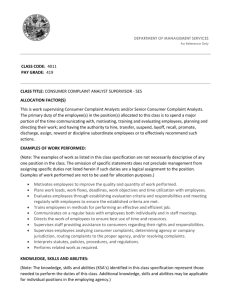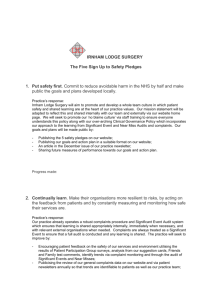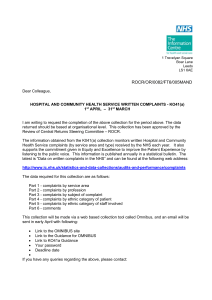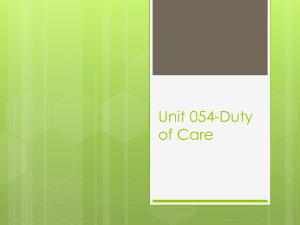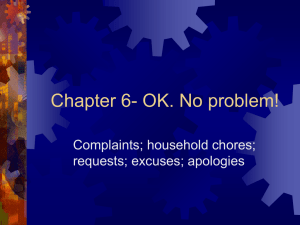Policy Analysis Tools for Policy Implementation Indicators 13
advertisement
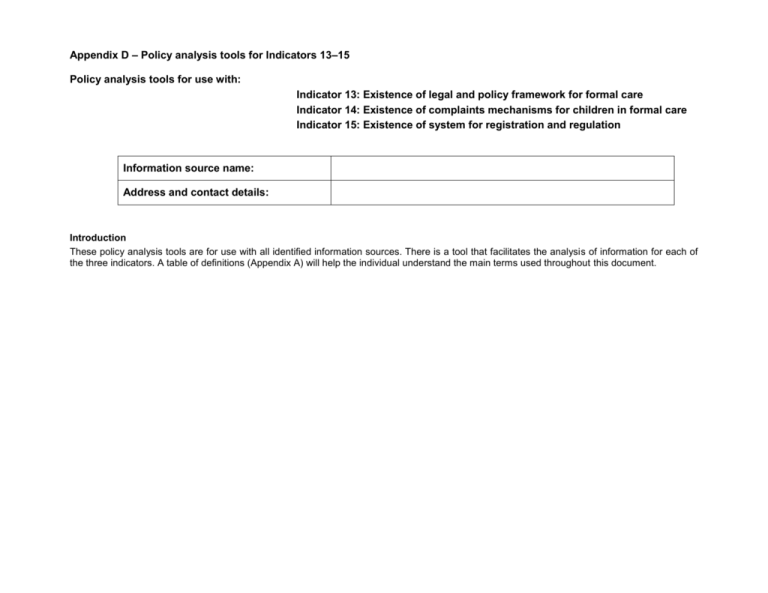
Appendix D – Policy analysis tools for Indicators 13–15 Policy analysis tools for use with: Indicator 13: Existence of legal and policy framework for formal care Indicator 14: Existence of complaints mechanisms for children in formal care Indicator 15: Existence of system for registration and regulation Information source name: Address and contact details: Introduction These policy analysis tools are for use with all identified information sources. There is a tool that facilitates the analysis of information for each of the three indicators. A table of definitions (Appendix A) will help the individual understand the main terms used throughout this document. Policy Analysis Tool 1: Existence of legal and policy framework for formal care Completion of Policy Analysis Tool 1 provides information for Indicator 13. Measurements The following instrument is intended to assist policy analysts in identifying and critically examining national frameworks and resulting practices for children without parental care and comparing them at a regional or global level. Its construction draws on instruments used at national levels, such as the Roeher Institute’s similar tool used in Canada, as well as evidence collected over the years by UNICEF about minimum standards for a legal/policy framework in formal care. This measurement tool aims to offer a systematic method for benchmarking formal care frameworks globally, thus facilitating reporting and national situation analysis regarding children without parental care. Information for this indicator may be gathered from governmental and institutional surveys and backed by court records, child welfare records (administrative and disciplinary), official reports, quantitative analysis and other record keeping systems. Scoring method Each area for analysis focuses on two levels of enquiry: laws and policy. Either the area exists in law or policy, or both. Wherever it exists, the survey question is given one point, and where it does not exist it is given zero. Thus, scoring would require completion as in the example below: Example Subject area Law Policy Survey questions Question 1 1 1 Question 2 0 1 Question 3 1 0 Question 4 0 0 2/4 2/4 Total Prevention of separation of children and families Law Policy Survey questions 1. Are the best interests of the child established as the overriding principle when considering the child’s separation from his/her parents? 2. Is the separation of children from their parent(s) precluded except in cases where abuse or neglect of the child by the parents has been determined by competent authorities, or when the parents are living separately and a decision must be made as to the child's place of residence? 3. When separation of children and parent(s) results from any action initiated by a state party against the parent, such as the detention, imprisonment, exile, deportation or death of a parent, is the child entitled to be informed about the whereabouts of his/her parent(s), unless the provision of the information would be detrimental to his/her well-being? 4. Is the separated child’s return to his/her own parents encouraged or prioritized? 5. Are there family tracing and family reunification programmes for children separated from their parents due to circumstances, for example, of deportation, immigration, armed conflict, emergencies or economic breakdown? 6. Do child welfare programming and planning require the inclusion of family preservation efforts? 7. Do the current frameworks – legal/policy, planning, programming, etc. – provide for budgetary measures, resources or support for family preservation, such as support for low-income and vulnerable families? 8. Are decisions on separation of children from their parents, including removal, relinquishment or custody, subject to review? Total /8 /8 Preference for placement of children in family-based care Law Policy Survey questions 1. Is family-based care, such as guardianship, foster care, Kafala in Islamic law or similar indigenous systems, a placement option for children without parental care? 2. In general, is there an established preference for family-based placements over institutional placements for children without parental care? 3. In particular, is there an established preference for family-based placements over institutional placements for infants or young children without parental care? 4. Are there designated quotas, allocations of budgetary resources or financial support measures for family-based care? 5. Are more resources to be allocated for family preservation efforts or family-based care models rather than for the placement and maintenance of children in institutions? Total /5 /5 Use of institutionalization as a last resort and temporary measure Law Policy Survey questions 1. Is the use of institutionalization of children without parental care established only as a temporary measure for the shortest time possible? 2. Is institutionalization established only as a measure of last resort for children without parental care? 3. Is the use of institutionalization established only as a temporary measure for children with special needs, such as physical or mental disabilities, learning disabilities or special educational needs? 4. Are decisions on institutional placement of children without parental care subject to periodic review? Total /4 /4 Child and youth involvement in placement decisions Law Policy Survey questions 1. Are children allowed to express their views when separation from their parent(s) is required by competent authorities? 2. Are children allowed to express their views in relation to their own permanency placement, such as in adoption or custody disputes? 3. Are children allowed to participate in decision-making proceedings for their separation or placement? 4. Are age limitations on the children’s right to be heard ruled out, keeping in mind that their views should be given due weight in accordance with their age and maturity? 5. Are children separated from their parent(s) or siblings entitled to maintain personal relations and direct contact with them, except if it is deemed contrary to the child's best interests? 6. Do parents of hospitalized children have visitation rights? 7. Is national adoption of children without parental care sanctioned and promoted? 8. Are detailed standards for childcare, including the prohibition of violence or maltreatment, set out for all services providing or supporting formal childcare? 9. Is the implementation of childcare regarding children in formal care monitored by an authorized body? Total Grand total of all survey questions Percentage /9 /9 /26 /26 /100 /100 Policy Analysis Tool 2: Existence of complaints mechanisms for children in formal care Completion of Policy Analysis Tool 2 provides information for Indicator 14. Measurements The following instrument is intended to assist policy analysts in identifying and critically examining the application and effectiveness of complaints procedures for children without parental care and comparing them at the regional or global level. This measurement tool aims to offer a systematic method for benchmarking complaints procedures in formal care settings globally, thus facilitating reporting on national analysis of the extent to which children in formal care can have their voice heard and receive an appropriate response. Information for this tool may be collected from governmental and institutional surveys backed by court records, formal care service providers’ child welfare records (administrative and disciplinary), official reports, quantitative analysis and other record keeping systems. Scoring method Each area for analysis focuses on two levels of enquiry: laws and policy. Either the area exists in law or policy, or both. Wherever it exists, then the survey question is given one point, and where it does not exist it is given zero. Thus, scoring would require completion as in the example below: Example Subject area Law Policy Question 1 1 1 Question 2 0 1 Question 3 1 0 Question 4 0 0 2/4 2/4 Survey questions Total This tool also includes two sections – quantitative elements of the complaints mechanism and an NGO survey – that are not scored. Instead, they offer a format to collect information that can be used to assess the incidence rate and frequency of these items, which can then be used to inform policy decisions. Existence of complaints mechanisms Law Policy Survey questions 1. Are all forms of neglect, abuse, exploitation or torture of children prohibited in formal care in public or private institutions, family-based care and juvenile custodial and detention centres? 2. Are there complaints mechanisms for children in formal care? 3. If there are not complaints mechanisms, are there any approved initiatives at the national or regional level regarding complaints mechanisms for children in formal care currently pending enactment? 4. If not, are there currently other channels through which the claims or complaints of children in formal care can be addressed? 5. Are children in institutional care or their representatives entitled to make individual requests or complaints to the director of the institution in which they are placed? 6. Is there a system of mandatory reporting to a complaints authority for professional staff, such as nurses or teachers, among others, working with and for children in formal care? 7. Can complaints on neglect, abuse, exploitation or torture be filed by or on behalf of children in formal care and assessed by independent competent authorities? 8. Can complaints on other grounds, such as living conditions, be filed by or on behalf of children in formal care and assessed by competent authorities? 9. Can complaints be filed by or on behalf of children in formal care before the child welfare system and/or judicial authorities? 10. If an internal complaints mechanism within the child welfare protection system exists, does it provide for the criminal, civil or family justice system to be used in conjunction with it? 11. Are children in formal care and their representatives to be informed of the outcomes or resolutions of their complaints? 12. Are decisions to be reasoned and explained to the complaining child and to her/his representatives? 13. Are reparations prescribed for children in formal care who are victims of neglect, abuse, exploitation or torture? 14. If so, do these reparations include other measures such as restitution of the child’s legal status or change of placement, among others? 15. Is there a person or monitoring body authorized to supervise the implementation of reparations to victims? Total Percentage /15 /15 /100 /100 Quantitative elements of the complaints mechanism Survey questions 1. How many complaints from or on behalf of children in formal care have been received within the child welfare system during the last 12 months? 2. How many complaints from or on behalf of children in formal care have been received in criminal, civil or family tribunals during the last 12 months? 3. How many complaints were filed by the children in formal care themselves? 4. How many complaints were filed by representatives or third parties on behalf of children in formal care? 5. How many complaints were related to neglect? 6. How many complaints were related to abuse? 7. How many complaints were related to exploitation? 8. How many complaints were related to torture or degrading or inhuman treatment? 9. How many complaints from or on behalf of children in formal care received a resolution, either judicial or non-judicial, during the last 12 months? 10. How many complaints were dismissed by judicial or non-judicial bodies on formal grounds during the last 12 months? 11. How many claims/complaints were dismissed by judicial or non-judicial bodies on substantial grounds during the last 12 months? 12. What was the average time elapsed between the date of receipt of the complaint and the date of its resolution? 13. How many complaints from or on behalf of children in formal care received a resolution in criminal, civil or family tribunals during the last 12 months? 14. What was the average time elapsed between the date of receipt of the complaint and the date of its resolution? 15. How many complaints from or on behalf of children in formal care were received by the child welfare system and resolved during the last 12 months by criminal, civil or family tribunals? 16. How many resolutions on neglect, abuse, exploitation or torture of children in formal care have resulted in criminal and/or civil convictions during the last 12 months? Number Additional NGO survey (backed by official reports, press releases and court records, among others) NGO survey to offer verification of the existence of, and measure the effectiveness of, accessibility and impartiality of the complaints mechanism Survey questions 1. How many complaints on neglect, abuse, exploitation or torture were brought before your organization by or on behalf of children living under formal care during the last 12 months? 2. How many of these complaints did your organization bring before local, regional or national authorities during the last 12 months? 3. Did your organization resort to an existing complaints mechanism within the child welfare or other systems? 4. In how many complaints related to neglect, abuse, exploitation or torture of children in formal care did your organization unofficially mediate between the affected child and child welfare authorities or affiliated persons during the last 12 months? 5. How many of these mediations were successful? 6. How many complaints about neglect, abuse, exploitation or torture of children in formal care has your organization brought before international bodies or organizations? 7. Were these complaints brought forward before or after exhausting domestic remedies? 8. How many complaints about neglect, abuse, exploitation or torture of children in formal care has your organization brought before the media? 9. Were these complaints brought forward before or after filing a complaint with official authorities? 10. From the total number of complaints in which your agency was involved, how many were resolved to the child's satisfaction? Number Policy Analysis Tool 3: Existence of system for registration and regulation Completion of Policy Analysis Tool 3 provides information for Indicator 15. Measurements This instrument is intended to assist policy analysts in identifying and critically examining the existence and effectiveness of systems for registration and regulation of formal care providers for children and comparing them at the regional or global level. The measurement tool aims to offer a systematic method for benchmarking registration and regulation procedures in formal care services globally, thus facilitating assessment of the extent to which opportunities for scrutiny, review and improvement of conditions in formal care exist. Information for this tool may be gathered at the central level from country legislation, governmental ministries such as ministries of child welfare, and existing literature and reports, and at the local level from social service organizations, departments that directly deliver formal care services, welfare homes, community volunteer organizations, NGOs, transit centres and places of detention. Scoring method Each area for analysis focuses on two levels of enquiry: laws and policy. Either the area exists in law or policy, or both. Wherever it exists, then the survey question is given one point, and where it does not exist it is given zero. Thus, scoring would require completion as in the example below: Example Subject area Law Policy Question 1 1 1 Question 2 0 1 Question 3 1 0 Question 4 0 0 2/4 2/4 Survey questions Total Existence of registration system Law Policy Survey questions 1. Is there an established system whereby any individual/agency that wishes to formally look after children either voluntarily, for profit or as part of a government function must register for approval with the government or an independent body? 2. Where such a system as in 1 exists, is the individual/agency required to meet minimum standards for registration set by the government or independent body before such registration can take place? 3. Is there an established system to regulate the status of registration through a process of periodic review of the registered individual/agency against a set of minimum standards? 4. Does the registering authority have the legal mandate to de-register an individual/agency that fails to comply with the minimum standards set for registration? Total Existence of inspection system /4 Law /4 Policy Survey questions 1. Is there an established system guaranteeing regular inspection visits by external, independent persons or bodies, such as inspectors or visiting committees, to places of detention where children in formal care are held? 2. Is there a system guaranteeing regular visits to formal care placements by social workers or other government social welfare senior management representatives? 3. If neither visits from independent persons nor from social welfare senior managers or social workers are guaranteed, are there any other mechanisms for regular scrutiny and improvement of formal care services? 4. Is the purpose of regular visits to evaluate compliance of the formal care service with laws and standards? Total /4 /4 Conduct of inspection Law Policy Survey questions 1. Are inspectors entitled to conduct unannounced inspections? 2. Are inspectors entitled to conduct inspections on their own initiative? 3. Are inspectors entitled to access all employees working in a formal care setting, including care workers and ancillary staff, in confidence? 4. Are inspectors entitled to access the records of employees working in a formal care setting? 5. Are inspectors entitled to access children looked after by the formal care service, in confidence? 6. Are inspectors entitled to access the records of children in formal care? 7. Are medical officers or public health services entitled to participate in inspections? Total Results of inspection /7 Law /7 Policy Survey questions 1. Are inspectors required to submit reports on the findings of inspection visits, including their evaluation and recommendations? 2. Is investigation and prosecution required when inspectors have found a potential violation of laws or standards concerning children in formal care? Total Grand total of all survey questions Percentage /2 /2 /17 /17 /100 /100 Collation of scoring from Policy Analysis Tools The tables below provide a simple means to generate an overview of the collated information from Policy Analysis Tools 1–3. Each table provides a summary of the three tools. In addition, it may be relevant to include here a summary of significant findings – both positive and negative – from the quantitative section of Policy Analysis Tool 2 for Indicator 14. Indicator 13: Existence of legal and policy framework for formal care Law Policy Subject area Prevention of separation of children and families /8 /8 Preference for placement of children in family-based care /5 /5 Use of institutionalization as a last resort and temporary measure /4 /4 Child and youth involvement in placement decisions /9 /9 Grand total /26 /26 Percentage /100 /100 Indicator 14: Existence of complaints mechanisms for children in formal care Law Policy Subject area Existence of complaints mechanisms Grand total /15 /15 Percentage /100/ /100 Indicator 15: Existence of a system of registration and regulation Law Policy Subject area Existence of registration system /4 /4 Existence of inspection system /4 /4 Conduct of inspection /7 /7 Results of inspection /2 /2 Grand total /17 /17 Percentage /100 /100

